- Prizes and Jackpots
- Sands Cotai Central win HK$1,000,000
- Latest Stud Poker and Slots Jackpot
- Grand Lisboa prizes up to HK$1,000,000
- Galaxy win up to HK$3,000,000
- City of Dreams prizes HK$12,000,000
- MGM prize win up to HK$5,288,888
|
|
| Fortresses |
发布者: admin 发布时间:2011/11/13 阅读:3364次 |
|
Fortresses
|
|
MountFortress
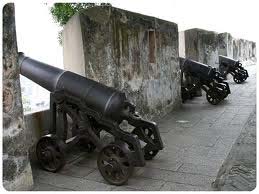
|
Mount Fortress, built in 1617-26, occupies a hilltop to the east of the ruins of St. Paul′ s. It was constructed by the Jesuits as part of a complex which also included the college and church of St. Paul′ s. The canons were used only once, when the Dutch invaded Macau in 1622. This was also the first residence of the governors of Macau. Over the following decades trees grew from the platform of the fort, which was transformed into a public park where residents and visitors came to enjoy the views. The only building was an office of the Meteorological Department until 1998 when the three-level Macau Museum, focusing on the history of Macau, was built into the fortress hill.
|
|
Mong-Ha Fort
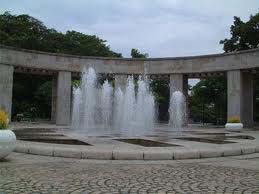
|
Mong Há Fort, situated on Mong Há Hill at the northern end of Macau, is a newer fortress, built in anticipation of a Chinese invasion following the Anglo-Chinese War in 1841. It was completed in 1866 and was in active service until the 1960′ s, when it was abandoned. Today the area has been turned into a park with flowerbeds, grassy slopes and walkways surrounding the old fortress walls. It provides a quiet refuge for people living in the nearby neighborhoods, and good views of the north end of the city.
|
|
St. Francisco Barracks
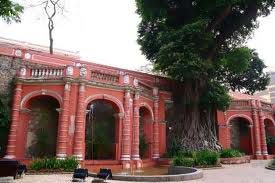

|
Built 1629 on the site of a battery which sank one of the warships' The Golias' of the Dutch invaders, the original fortress of S. Francisco stood at the end of old Praia Grande, facing the Taipa channel. Its armaments included a culverin, which could fire 35-pound iron shots a distance of one and a half miles (the width of the channel). Little more is known of the original fort or the convent of S. Francisco, which was attached to it.
Both fort and convent were demolished to make way for new barracks in 1864, to house the Battalion of the First Line, brought in as defence against a Chinese attack which never came. The barracks survive today as headquarters for the Security Forces and sections of the Police Force. They present an attractive, colonial facade of pink-washed stone with white trim. Inside are offices and meeting rooms around a flag-stoned courtyard, in the spacious lobby are display cases filled with old prints and pictures of the previous fort and convent, a collection of old weapons and other.
|
|
Guia Fortress
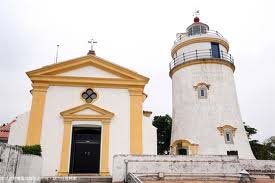

|
Guia Fortress, built in 1622-1638, occupies the top of Guia Hill, the highest point in Macau. It was designed to defend Macau from attacks from the sea, but because of its position overlooking the entire city, its chief value has been as an observation post. It originally contained barracks, a water cistern, ammunition and equipment stores, the commander's house, and a chapel dedicated to Our Lady of Guia. Today the Fort's most prominent feature is the lighthouse, built in 1864 and the oldest on the China coast. It is 15 metres high and has a light which can be seen for around 20 miles in clear weather. Near the lighthouse is the chapel which contains an image of the Virgin Mary, a few antique pictures, and vestiges of paintings that date back to the construction of the chapel in 1622. Also nearby is a post where signals are hoisted to warn of an approaching typhoon. In earlier times storm warnings were announced from the bell-tower of the chapel.
|
|
Barra Fort
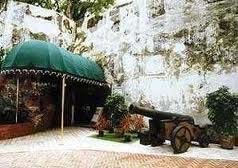
|
Completed in 1629 on the site of an older cannon battery, Barra fort successfully protected the bar at the entrance to the Inner Harbour against the Dutch in 1622. Such credit was given to the fort, that between the 17th and 18th centuries, the commander of the fort was chosen directly by the king of Portugal and was not under the orders of the Macau governor or the captain general. The fort was described as a small town, built into the hills on the tip of the peninsula. The 30-feet chunambo walls, rising from stone foundations, were 19 feet thick at the base and 11 feet at the top. The main platform was 375' by 1.38' and supported 12 cannons of 24-pound calibre and four 50 pounders, a water cistern with 3,000-ton capacity and quarters for the commander and 60 soldiers. Higher up the hill was a guardhouse and six 24-pound cannons, while at ground level were stores for ammunitions and supplies, as well as a large house.
In 1740 a chapel was built in the fort, dedicated to St. James (S. Tiago), patron saint of the military. Legend has it that the saint' s statue would patrol the fort at night and have mud on his boots in the morning, so a soldier was detailed to clean them. On one occasion it' s said the soldier failed to do so and was hit on the head by St. James' sword.
After 1622 the fort' s cannons were never needed, until World War II when they were sold for rice to feed refugees from Hong Kong and Mainland China. Over the years the fort was gradually demolished to make room for roads and by 1976 it was abandoned by the Marine Police. The Macau Government Tourist Office decided to convert the ruins into a Portuguese inn, which today is one of the city' s great attractions. To discover how the architect used the original walls, made the cistern into a fountain, incorporated century-old trees into the design and restored the chapel, visitors are welcome any time at the Pousada de Sao Tiago.
|
|
|
|
|
|